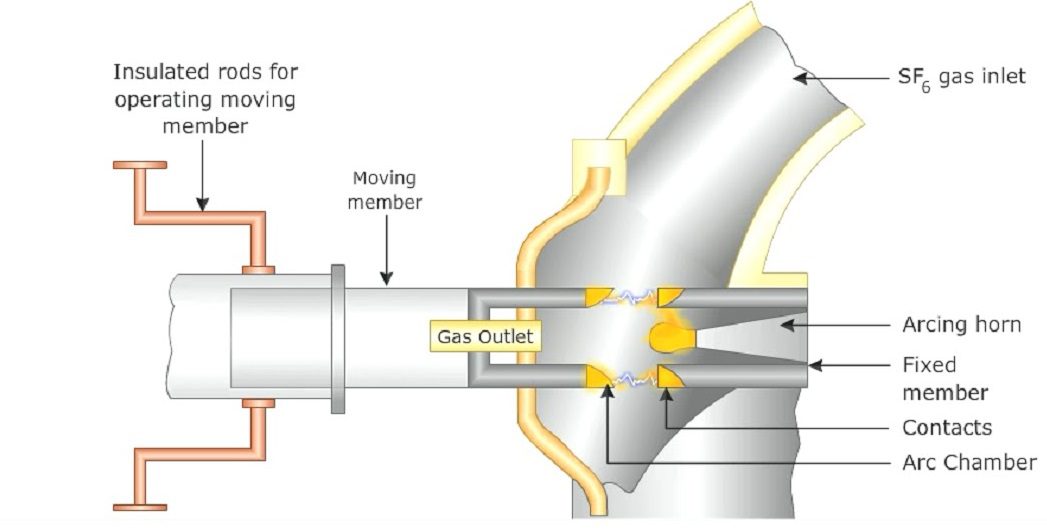Sulphur Hexafluoride(SF6) circuit breaker:
In SF6 circuit breakers, sulphur hexafluoride (SF6) gas is used as the arc quenching medium. The SF6 is an electro-negative gas and has a strong tendency to absorb free electrons. The contacts of the breaker are opened in a high-pressure flow of SF6 gas and an arc is struck between them. The conducting free electrons in the arc are rapidly captured by the gas to form relatively immobile negative ions. This loss of conducting electrons in the arc quickly builds up enough insulation strength to extinguish the arc. The SF6 circuit breakers have been found to be very effective for high power and high voltage service.

Construction of SF6 circuit breaker:
The figure above shows the parts of a typical SF6 circuit breaker.It consists of fixed and moving contacts enclosed in a chamber (called arc interruption chamber) containing SF6 gas. This chamber is connected to the SF6 gas reservoir.When the contacts of breaker are opened, the valve mechanism permits a high-pressure SF6 gas from the reservoir to flow towards the arc interruption chamber.
The fixed contact is a hollow cylindrical current carrying contact fitted with an arcing horn. The moving contact is also a hollow cylinder with rectangular holes in the sides to permit the SF6 gas to let out through these holes after flowing along and across the arc. The tips of fixed contact, moving a contact and arcing horn are coated with copper-tungsten arc-resistant material. Since SF6 gas is costly, it is reconditioned and reclaimed by a suitable auxiliary system after each operation of the breaker.
Working Principle of SF6 circuit breaker:
In the closed position of the SF6 circuit breaker, the contacts remain surrounded by SF6 gas at a pressure of about 2·8 kg/cm2. When the breaker operates, the moving contact is pulled apart and an arc is struck between the contacts. The movement of the moving contact is synchronized with the opening of a valve which permits SF6 gas at 14 kg/cm2 pressure from the reservoir to the arc interruption chamber.
The high-pressure flow of SF6 rapidly absorbs the free electrons in the arc path to form immobile negative ions which are ineffective as charge carriers. The result is that the medium between the contacts quickly builds up high dielectric strength and causes the extinction of the arc. After the breaker operation (i.e., after arc extinction), the valve is closed by the action of a set of springs.
Know more about
- PCB Manufacturing
- PCB assembliesSF6 circuit breakers Advantages:
Due to the superior arc quenching properties of SF6 gas, the SF6 circuit breakers have many advantages over oil or air circuit breakers. Some of them are listed below :
(i) Due to the superior arc quenching property of SF6, such circuit breakers have very short arcing time.
(ii) Since the dielectric strength of SF6 gas is 2 to 3 times that of air, such breakers can interrupt much larger currents.
(iii) The SF6 circuit breaker gives noiseless operation due to its closed gas circuit and no exhaust to atmosphere, unlike the air blast circuit breaker.
(iv) The closed gas enclosure keeps the interior dry so that there is no moisture problem.
(v) There is no risk of fire in such breakers because SF6 gas is non-inflammable.
(vi) There are no carbon deposits so that tracking and insulation problems are eliminated.
(vii) The SF6 Circuit breakers have a low maintenance cost, light foundation requirements and minimum auxiliary equipment.
(viii) Since SF6 breakers are totally enclosed and sealed from the atmosphere, they are particularly suitable where explosion hazard exists e.g., coal mines.
SF6 circuit breakers Disadvantages:
(i) SF6 breakers are costly due to the high cost of SF6.
(ii) Since SF6 gas has to be reconditioned after every operation of the breaker, additional equipment is required for this purpose.
SF6 circuit breakers Applications:
A typical SF6 circuit breaker consists of interrupter units each capable of dealing with currents up-to 60 kA and voltages in the range of 50—80 kVA number of units are connected in series according to the system voltage.SF6 circuit breakers have been developed for voltages 115 kV to 230 kV, power ratings 10 MVA to 20 MVA and interrupting time less than 3 cycles.
I wish we had SF6 breakers in my day as an operational engineer. On several occasions I had to close on a fault with OCBs. The most reliable were Reyrolle and even with those it sometimes best to leg it after closure.